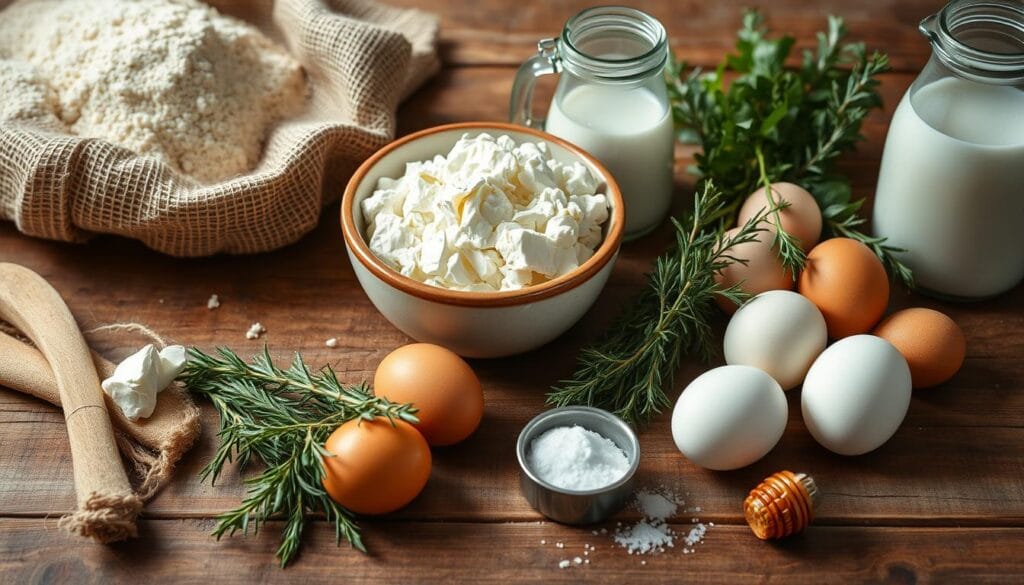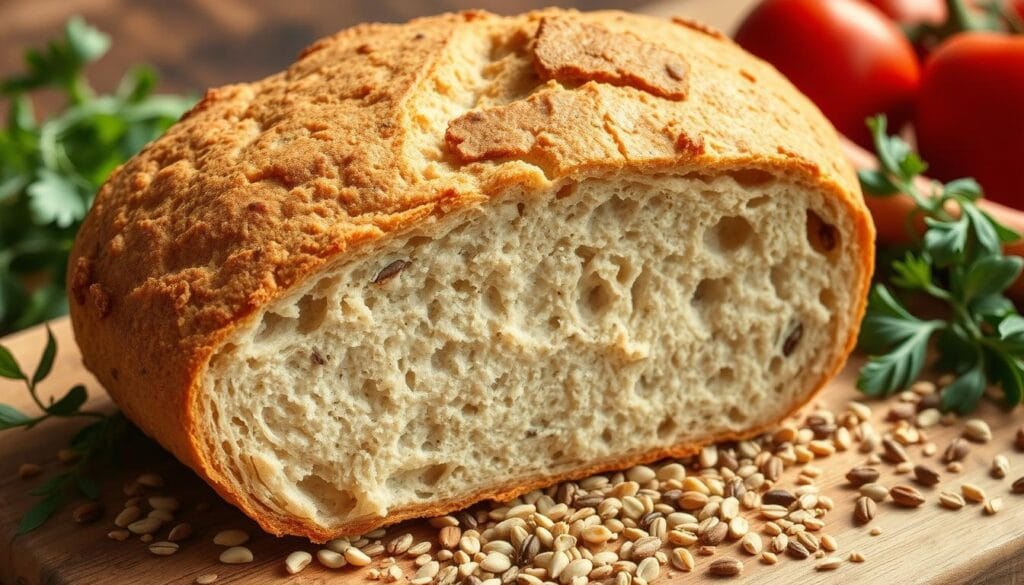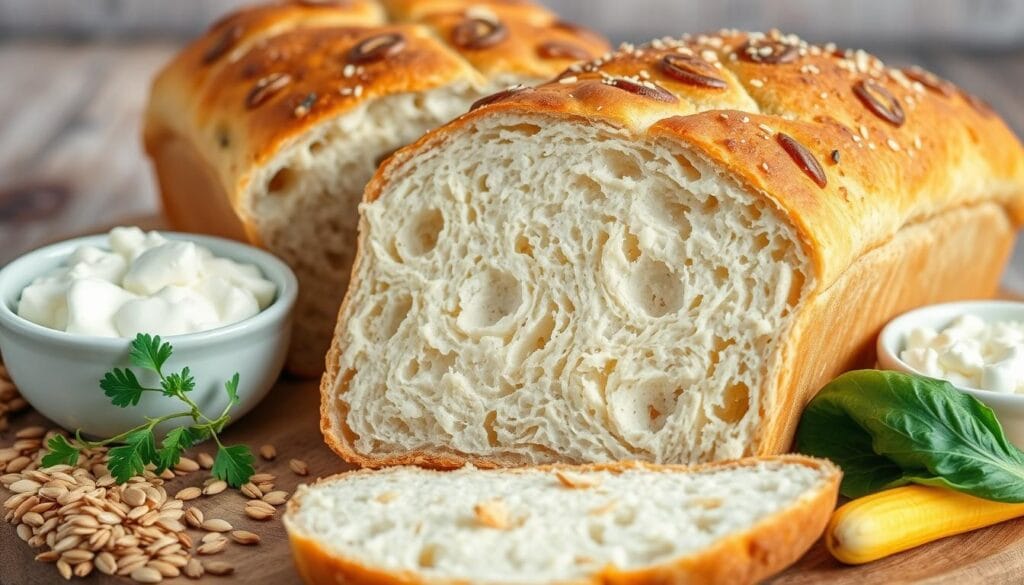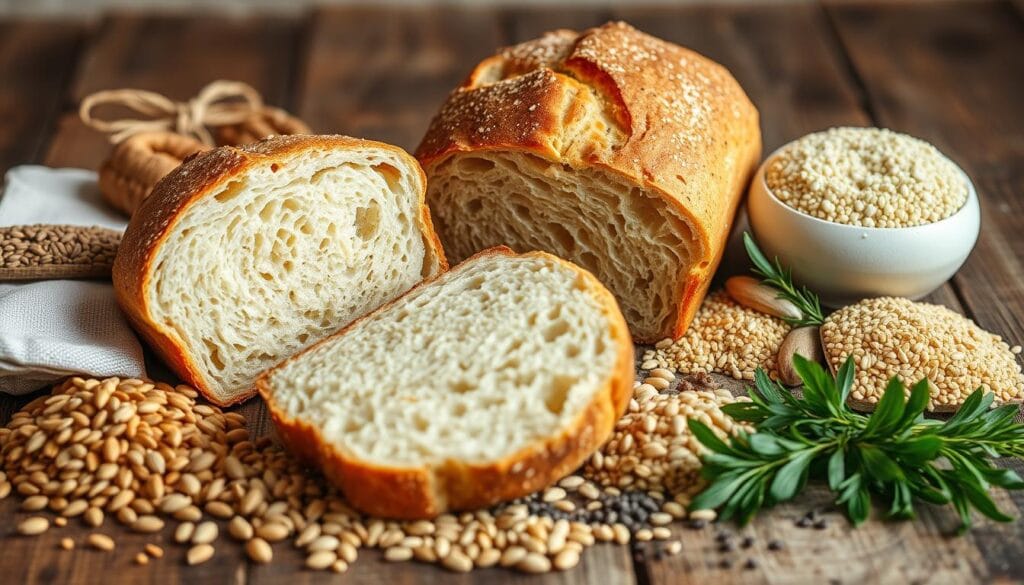I’m always looking for healthier food options. That’s why cottage bread caught my eye. It’s packed with protein, low in carbs, and gluten-free. This makes it a great choice for those who want a nutritious bread.
It’s made from simple ingredients like cottage cheese, eggs, and sometimes oats. This makes it a healthier alternative to regular bread. Let’s explore the benefits and nutrition facts of cottage bread together.
Understanding Cottage Bread: A Comprehensive Overview
Cottage bread is a special type of bread that’s become very popular. It’s different from regular American breads. It’s made with cottage cheese, eggs, and spices, making it rich in nutrients and protein.
This bread is moist, flavorful, and perfect for those who care about their health. It fits right into today’s baking trends.
Traditional Cottage Bread-Making Process
Making cottage bread is easy. You mix cottage cheese, eggs, and sometimes oats or seeds. Then, you bake it until it’s just right.
You can add herbs, spices, and other ingredients to make it your own. To bake, preheat your oven to 350°F. Bake for about 60 minutes.
Key Components of Cottage Bread
- Cottage Cheese: The main ingredient, adding creaminess and protein.
- Eggs: Eggs help the bread stick together and add nutrition.
- Oats or Seeds: Rolled oats or seeds like flax or chia add fiber and a nutty taste.
- Seasonings: You can use herbs, spices, and other flavors to make it taste unique.
Historical Significance in American Baking
Cottage bread isn’t a traditional American bread. But, it’s a modern, healthy choice that’s gaining fans. It uses cottage cheese and eggs, making it a high-protein, low-carb option.
This bread offers a fresh take on the classic loaf. It meets the needs of health-conscious eaters.

Nutritional Profile of Cottage Bread
Cottage bread is a mix of good stuff like protein, vitamins, and minerals. A half flatbread has about 168 calories and 17 grams of protein. It also has 9 grams of fat, 3 grams of saturated fat, 5 grams of carbohydrates, and 3 grams of sugar.
It’s a good source of calcium with 128 milligrams per serving. It also has 393 milligrams of sodium. But, it’s low in fiber with only 0.4 grams. The exact amounts can change based on the cottage cheese type and any extra ingredients.
| Nutrient | Amount per Serving (1/2 flatbread) |
|---|---|
| Calories | 168 |
| Protein | 17 g |
| Fat | 9 g |
| Saturated Fat | 3 g |
| Carbohydrates | 5 g |
| Sugar | 3 g |
| Fiber | 0.4 g |
| Calcium | 128 mg |
| Sodium | 393 mg |
| Potassium | 183 mg |
Cottage bread is great for those who want more protein and less carbs. But, it has less fiber, so it might not be the best for everyone.
Is Cottage Bread Healthy: Analyzing Its Health Impact
Cottage bread seems to be quite healthy. It has many benefits that make it good for those who care about their health.
Blood Sugar Response
Cottage bread is great for managing blood sugar. It has a lot of protein from cottage cheese. This protein slows down how carbs are absorbed.
This helps keep blood sugar levels steady. It’s good for people watching their blood sugar or eating low-carb.
Digestive Health Benefits
Cottage bread might also help your digestion. It could have probiotics from the cottage cheese. These probiotics help your gut stay healthy.
The bread also has fiber. Fiber helps with regular bowel movements and better digestion.
Weight Management Considerations
For weight management, cottage bread is a good choice. Its high protein makes you feel full. This can help you eat fewer calories and lose weight.
It also has less carbs than regular bread. This makes it great for low-carb diets.
In summary, cottage bread is a healthy option. It’s good for blood sugar, digestion, and weight management. But, remember to eat it in moderation and as part of a balanced diet.
Comparing Cottage Bread to Other Bread Types
Whole wheat cottage bread is different from regular bread. It has more protein and less carbs. It also has fewer preservatives and additives than many store-bought breads.
While it may not have as much fiber as true whole wheat or multigrain breads, it has more protein. This makes it great for those who want a protein-rich bread. It’s also good for people with gluten sensitivities because it’s gluten-free when made with certified gluten-free oats.
| Bread Type | Calories | Fat (g) | Sodium (mg) | Carbs (g) | Fiber (g) | Protein (g) |
|---|---|---|---|---|---|---|
| Whole Wheat Cottage Bread | 100 | 1 | 170 | 16 | 3 | 10 |
| Whole Wheat Bread | 110 | 2 | 170 | 21 | 3 | 4 |
| Multigrain Bread | 90 | 1.5 | 150 | 16 | 4 | 5 |
Whole wheat cottage bread has a special nutritional profile. It has more protein and less carbs than other breads. This makes it a good choice for those who care about their health.
Fiber Content and Its Benefits in Cottage Bread
The fiber in high-fiber cottage bread is key to its nutrition. Traditional cottage bread has about 0.4 grams of fiber per serving. But, adding oats or seeds can increase the fiber a lot.
Soluble vs. Insoluble Fiber
Cottage bread has both soluble and insoluble fiber. Soluble fiber, like in oats, makes you feel full longer. Insoluble fiber, found in wheat bran, helps keep your bowels regular and supports digestion.
Daily Fiber Requirements and Cottage Bread’s Contribution
Adults need 25 to 30 grams of fiber each day. A slice of high-fiber cottage bread doesn’t give you much. But, it’s good when eaten with other fiber-rich foods like fruits, veggies, legumes, and whole grains.
| Nutrient | Amount per Serving |
|---|---|
| Calories | 194 |
| Carbohydrates | 27g |
| Protein | 10g |
| Fat | 6g |
| Sodium | 494mg |
| Potassium | 175mg |
| Fiber | 4g |
| Sugar | 2g |
Eating high-fiber cottage bread boosts your fiber intake. This can improve digestion, help control blood sugar, and make you feel fuller. Adding it to your diet can make your meals more nutritious.

Protein and Essential Nutrients in Cottage Bread
Cottage bread is packed with protein, offering 17 grams per serving. It’s also rich in essential vitamins and minerals. This makes it a great choice for your diet.
The secret to cottage bread’s nutritional value is its ingredients. Cottage cheese adds a lot of protein and important minerals like calcium and phosphorus. Eggs in the dough add vitamins and minerals, including vitamin D and choline. These are key for health and body functions.
- Each serving of cottage bread contains 17 grams of protein, supporting muscle growth, repair, and maintenance.
- The bread provides 128 mg of calcium per serving, promoting strong bones and teeth.
- Cottage bread is a source of phosphorus, an essential mineral that works in tandem with calcium to keep your bones healthy.
- Vitamin B12, found in the cottage cheese, plays a vital role in red blood cell formation and neurological function.
- Eggs in the bread contribute vitamin D and choline, which are important for immune health, brain function, and more.
Adding cottage bread to your diet means you’re getting a lot of protein and important nutrients. These support muscle health, bone strength, and overall wellbeing. Enjoy the delicious taste and nutritional benefits of this versatile baked good.
The Role of Whole Grains in Cottage Bread
Cottage bread recipes often use whole wheat and multigrain varieties. This makes the bread more nutritious. Whole grains also make the bread more filling and satisfying.
Types of Whole Grains Used
Many cottage bread recipes mix different whole grains. Oats, for example, add a lot of fiber and B vitamins. This makes the bread healthier than bread made with refined flours.
Nutritional Advantages of Whole Grain Varieties
- Improved blood sugar control: Whole grain cottage bread helps keep blood sugar levels stable. This is because it has more fiber and a lower glycemic index.
- Better digestive health: The extra fiber from whole grains helps with regular bowel movements. It also supports a healthy gut.
- Potential heart health benefits: Eating whole grains can lower the risk of heart disease and other heart problems.
When choosing whole wheat cottage bread or multigrain cottage bread, pick options with whole grains as the main ingredient. This way, you get the most nutritional benefits.
| Whole Grain | Fiber (per slice) | Protein (per slice) | Health Benefits |
|---|---|---|---|
| Whole Wheat | 3-4 grams | 3-4 grams | Reduced risk of heart disease, diabetes, and certain cancers |
| Oats | 2-3 grams | 3-4 grams | Cholesterol-lowering, heart-healthy, and blood sugar-regulating properties |
| Flax Seeds | 3-4 grams | 2-3 grams | Rich in omega-3 fatty acids, antioxidants, and lignans for overall health |
Making Healthier Choices: What to Look for in Cottage Bread
Choosing healthier cottage bread is key for good nutrition. Look for recipes with low-fat cottage cheese and whole grains or seeds. This way, you get to enjoy the bread’s taste while getting health benefits.
Low-fat cottage bread is a good choice because it’s lower in fat. Choose versions with low-fat or nonfat cottage cheese. This change cuts down on saturated fat and calories, making the bread healthier.
Also, find high-fiber cottage bread with whole grains, seeds, or fiber-rich ingredients. Whole grains like whole wheat flour or oats add nutrients and fiber. Seeds, like flaxseeds or chia seeds, boost fiber and nutrients even more.
Be careful of the sodium in pre-made cottage bread. Some have too much sodium, which isn’t good for your heart. Choose low-sodium options or make your own to control the ingredients.
To make homemade cottage bread even better, add veggies or fresh herbs. Chopped veggies like spinach, bell peppers, or onions add vitamins and minerals without many calories. Herbs like rosemary or thyme add flavor and aroma without salt or sugar.
By choosing low-fat, high-fiber cottage bread and smart ingredients, you can enjoy its taste while staying healthy.

Potential Benefits for Heart Health and Digestion
Cottage bread is high in protein, which can help your heart. It makes you feel full and helps with weight control. Some cottage bread has omega-3 fatty acids from seeds, which are good for your heart.
The probiotics in cottage cheese can also help your digestion. They keep your gut healthy and balanced.
Cardiovascular Health Impact
The protein in cottage bread keeps you full. This can help you manage your weight and lower heart disease risk. Some recipes add seeds like flaxseeds or chia seeds.
These seeds are full of omega-3 fatty acids. They can lower your blood pressure and cholesterol. This is good for your heart.
Digestive System Benefits
Cottage bread may have probiotics from cottage cheese. Probiotics are good bacteria that help your digestion. They keep your gut healthy.
The bread has low carbs. This can help control your blood lipid levels. This is key for heart health.
| Nutrient | Potential Health Benefits |
|---|---|
| Protein | Promotes feelings of fullness, supports weight management, and contributes to heart health. |
| Omega-3 Fatty Acids | Helps lower blood pressure and cholesterol levels, reducing the risk of heart disease. |
| Probiotics | Improve digestion and support a healthy gut microbiome. |
| Low Carbohydrates | May help in managing blood lipid levels, which is important for cardiovascular health. |
Adding cottage bread benefits and health benefits of cottage bread to your diet can help your heart and digestion. Cottage bread’s mix of nutrients makes it a great choice for a healthy diet.
Common Misconceptions About Cottage Bread
Many people think cottage bread is bad for weight loss because it’s high in carbs. But, cottage bread can actually have fewer carbs than regular white bread. This makes it a good choice for those watching their calories.
Some think cottage bread tastes boring. But, you can add herbs and spices to make it taste great. Also, cottage bread isn’t always gluten-free. It depends on what ingredients you use.
- Cottage bread is not necessarily high in carbs or unsuitable for weight loss diets.
- Cottage bread can be flavored with herbs and spices, dispelling the myth of it being bland.
- The gluten content of cottage bread depends on the recipe and ingredients used, not a universal characteristic.
By clearing up these myths, we can see cottage bread in a new light. It’s a healthier option than regular bread and can be made to taste amazing. So, let’s give cottage bread a chance and see what it offers.

Conclusion
Cottage bread is a healthy choice compared to regular bread. It has lots of protein, fewer carbs, and is full of good nutrients. It can help with weight, muscle, and even digestion health.
But, it’s not for everyone, like those with lactose issues. Still, its health benefits and variety make it great for many looking for better bread.
It has 9 to 15 grams of protein per slice. This is perfect for athletes and older folks who need more protein. Plus, it has only 0.3 grams of carbs, great for keto, low-carb, or gluten-free diets.
Looking to get healthier, manage weight, or just enjoy tasty bread? Cottage bread is a good pick. It’s good for your heart and digestion, and you can flavor it in many ways.
Adding cottage bread to your meals can make a big difference. It’s a simple way to eat better and feel better.
FAQ
What is cottage bread?
Cottage bread is a protein-rich bread made with cottage cheese, eggs, and sometimes oats. It’s low in carbs and high in protein (17g per serving). It’s also gluten-free if you use certified gluten-free oats.
What are the key components of cottage bread?
Cottage bread is made with cottage cheese, eggs, and sometimes oats or seeds. You can add different seasonings and ingredients to it.
How does the nutrition of cottage bread compare to traditional bread?
Cottage bread has more protein and less carbs than regular bread. It also has fewer preservatives and additives.
Is cottage bread a good option for weight management?
Yes, cottage bread is great for weight management. It’s high in protein and low in carbs. It’s best when part of a balanced diet.
How much fiber does cottage bread contain?
Cottage bread usually has little fiber (0.4g per serving). But, adding oats or seeds can increase the fiber.
What are the health benefits of cottage bread?
Cottage bread is packed with protein, about 17g per serving. It also has calcium, phosphorus, and vitamin B12. These nutrients help muscles, bones, and overall health.
Are there any misconceptions about cottage bread?
Some think cottage bread is always high in carbs or not good for weight loss. Others believe it lacks flavor or is always gluten-free.

